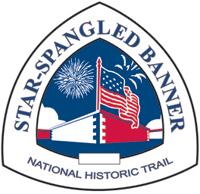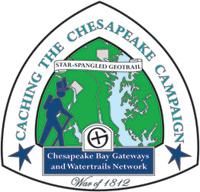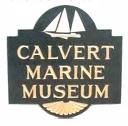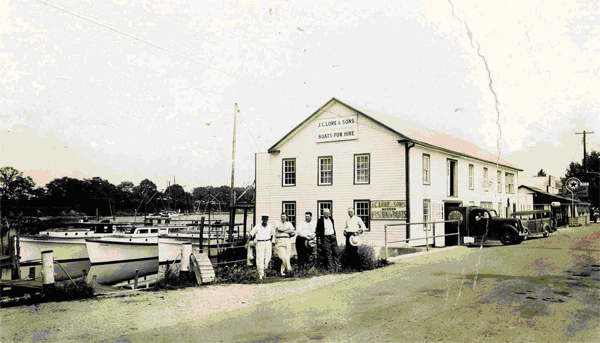The cache container was replaced on 1/17/11 with a small waterproof
match stick container. Please bring your own writing tool.


Come on a journey to remember and commemorate
the dramatic chain of events, people and places that led to the
birth of our National anthem.
The story of the Star-Spangled Banner was shaped by the events of
the Chesapeake Campaign during the War of 1812. From February 1813
until February 1815, the Chesapeake Bay was the center of a fierce
struggle between the British and Americans. Places and landscapes
still exist today that provide a touchstone to the past. The trail
traces events and related sites that figured prominently in the
Chesapeake Campaign of the War of 1812 that have national
significance, physical integrity, and the potential for
contemporary recreation and interpretation.
The Star-Spangled Banner (SSB) Geotrail launched February 27, 2010
with over 30 caches within Maryland, Virginia and the District of
Columbia. A trackable geo coin will be awarded to the first 400
geocachers, while supplies last, for locating at least 20 SSB
caches. To be eligible for the coin, geocachers must download a
passport from either the SSB
Geotrail or Maryland Geocaching
Society website. Geocachers must find and log at least 20
SSB finds, record the code word from each cache on their passport
and post a picture of themselve at each cache location. After
discovering the 20 required caches, geocachers may have their
passports validated in person or via mail at the Friends of
Chesapeake Gateways office located at 410 Severn Ave, Suite 314,
Annapolis, MD 21403. Please refer to the passport for complete
validation instructions.
Participating in the SSB geotrail is fun and we
hope that many people join in. However, it is not a requirement for
logging your find on this cache once you find the
container.

You are seeking a traditional cache hidden at the historic J.C.
Lore & Sons Oyster House. This location is designated a
National Historic Landmark. The museum has limited hours but you do
not need to enter the museum to locate the cache.

Please note that at times ** EXTREME STEALTH ** will be
required to find this cache. This cache is located in a very
popular tourist spot and many windows open up onto the area.
Muggles abound!
The difficulty for this cache is rated at a 1 because it is a very
basic hide. Yet, this is a popular destination for tourists. Please
do not get frustrated if you cannot seek this cache because of the
muggle activity. Please place the cache back exactly where you
found it.
The community of Solomons (also called Solomon's Island, referred
to as Somervell's Island at the time of the War of 1812) is located
at the convergence of the Patuxent River and Chesapeake Bay in
southern Maryland. Calvert Marine Museum features interpretive
displays that tell of the story of the War of 1812 in the southern
Chesapeake Bay, including artifacts recovered from a vessel of the
United States Chesapeake Flotilla, scuttled by the Americans above
Pig Point on the Patuxent. Interesting items include surgical
implements, stoneware, lantern and padlocks. The Museum also
features an electric map of the British invasion route up the
Patuxent River.
The creation of a United States Chesapeake Flotilla
was largely the inspiration of Revolutionary War hero Joshua
Barney, who came out of retirement to propose the idea in 1813. He
envisioned a flying squadron of twenty shallow draft barges, built
to defend Chesapeake Bay from British incursions. Outfitted and
ready to sail by late spring 1814, the Flotilla departed from
Baltimore to engage the better-equipped British fleet. Several
clashes would occur over the next few months, including battles at
Cedar Point and St. Leonard’s Creek in June. Barney’s
hit and run tactics proved frustrating to the British, who
retaliated by brutally burning and plundering communities along the
Patuxent River.
In the end, Barney was unable to elude his Royal
Navy pursuers, who followed the Flotilla up the Patuxent in late
summer 1814. Concerned that the collection of gunboats and barges
might fall into British hands, Secretary of the Navy William Jones
ordered Barney to sail as far north as Pig Point and then scuttle
all the ships if the enemy approached. On August 22, 1814, the
British Army and Navy came within view and Barney ordered the
entire fleet destroyed. His men then marched with their cannon
towards Washington, where they were to join the Battle of
Bladensburg. It is the remains of one of these scuttled ships,
which a visitor may see on a visit to the
museum.
Visitors to the museum today can see many
fascinating exhibits including displays on the history of
Solomon’s Island and locally found fossils. There is also a
Discovery room for kids and live otter located in an outside pool.
In addition to a museum, the organization’s grounds are home
to a marsh walk, woodcarving and model boat shop, Drum Point
Lighthouse and a century old bugeye buyboat, the Wm. B.
Tennison.

Thanks to Calvertcachers & SeeKPeeKRs for
helping with this hide and to the Maryland Geocaching Society for
assisting with this project!